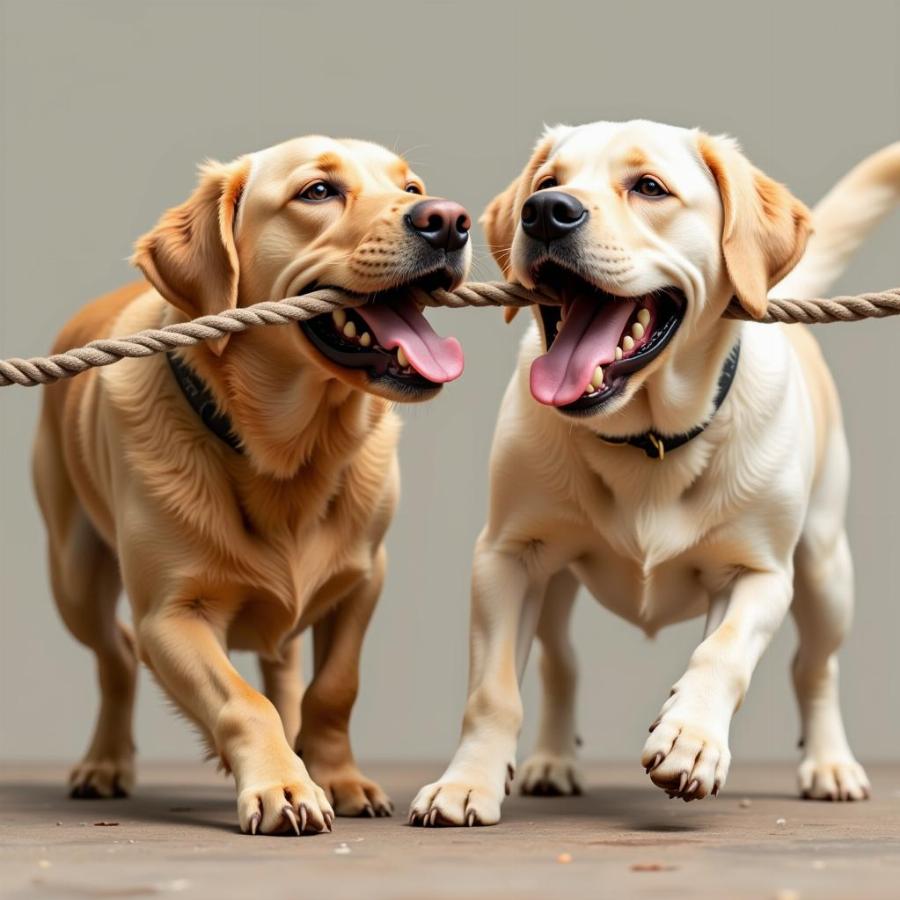Understanding whether your dogs are playing or fighting is crucial for their safety and well-being. It’s not always easy to distinguish between playful roughhousing and genuine aggression, and misinterpreting the situation can have serious consequences. This article will equip you with the knowledge to accurately interpret canine body language, recognize the signs of play, identify red flags that signal a fight, and understand how to intervene safely if necessary.
Decoding Canine Body Language: Play vs. Fight
Dogs communicate primarily through body language. While some signals are clear indicators of play or aggression, others can be more subtle. Learning to read these cues is essential for understanding your dog’s interactions. Playful dogs often exhibit loose, bouncy body movements, wagging tails, play bows (front end lowered, rear end up), and open mouths with relaxed panting. A playful dog’s posture is generally relaxed, and they might engage in role reversal, taking turns being the “chaser” and the “chased.” Conversely, a dog showing aggression might have a stiff posture, a tucked tail, raised hackles (the fur along their back), bared teeth, and hard stares. Growling, snapping, and lunging are also clear signs of aggression. Remember that context plays a crucial role. Even seemingly playful behaviors can escalate into aggression if one dog becomes uncomfortable or overly aroused.
 Two dogs playfully tugging on a rope toy
Two dogs playfully tugging on a rope toy
Is It Rough Play or a Real Fight? Key Indicators
Differentiating between rough play and fighting can be challenging, especially for new dog owners. One crucial indicator is the presence of play bows. These bows are a clear signal that the interaction is meant to be playful. Another important factor is reciprocity. During play, dogs typically take turns being dominant. If one dog consistently dominates the other, it could be a sign of bullying rather than play. Pay attention to vocalizations. Playful growls are typically higher-pitched and accompanied by relaxed body language. Aggressive growls, however, are low and guttural, often accompanied by stiff posture and bared teeth.
What to Do if Your Dogs Start Fighting
If your dogs start fighting, it’s essential to intervene quickly and safely. Never attempt to physically separate fighting dogs with your hands, as you risk serious injury. Instead, try to create a distraction. A loud noise, like banging a pot or lid, can sometimes startle the dogs and break up the fight. Alternatively, you can try throwing a blanket or large towel over them to disrupt their vision. Once the dogs are separated, secure them in different areas and assess for injuries. If either dog is injured, seek veterinary attention immediately. After a fight, it’s crucial to identify the underlying cause of the aggression and work with a qualified dog trainer or behaviorist to develop a management plan and prevent future incidents. [why do my dogs keep fighting](https://beautdogs.com/why-do-my dogs-keep-fighting.html) can help you to understand the triggers and learn effective intervention techniques.
How Can I Tell if My Dogs are Playing Too Roughly?
While rough play is a normal part of canine interaction, it’s essential to ensure it doesn’t become too intense. Look for signs of stress or discomfort, such as whale eyes (showing the whites of their eyes), lip licking, yawning, and tucked tails. If one dog is consistently trying to avoid the other or showing appeasement signals like rolling onto their back, it’s a sign the play has become too rough. the curious incident of the dog in the nighttime film offers an interesting perspective on how dogs perceive the world, highlighting the importance of understanding their communication cues.
Conclusion
Distinguishing between dogs playing or fighting is a critical skill for any dog owner. By learning to recognize the nuances of canine body language, you can ensure the safety and well-being of your furry companions. Remember, observation is key. Pay close attention to their posture, vocalizations, and overall demeanor. If you’re ever unsure, err on the side of caution and intervene to prevent any potential escalation. Understanding the difference can help you create a harmonious multi-dog household.
FAQ
-
What are the most common signs of dog aggression? Stiff posture, bared teeth, growling, snapping, lunging, and a tucked tail.
-
How can I encourage appropriate play between my dogs? Provide plenty of toys, supervise play sessions, and intervene if play becomes too rough.
-
Should I let my dogs “work it out” if they have a minor disagreement? No, it’s best to intervene and redirect their behavior before it escalates.
-
What should I do if one of my dogs is consistently bullying the other? Consult with a qualified dog trainer or behaviorist to address the underlying issues.
-
Can dogs who have fought in the past ever live together peacefully? Yes, in many cases, with proper management and behavioral modification.
-
Are some dog breeds more prone to aggression than others? While any dog can exhibit aggression, certain breeds might have a higher predisposition due to genetic factors or historical breeding purposes. calico cat and the gingham dog provides further insights into animal behavior and interaction.
-
How can I tell if my dog’s growling is playful or aggressive? Playful growls are usually higher-pitched and accompanied by relaxed body language. Aggressive growls are low and guttural and accompanied by tense body language.
Further Reading and Questions
For more information about dog behavior, training, and breeds, check out why were pitbulls called nanny dogs and america’s got talent dogs.
Beaut Dogs is your ultimate resource for all things canine. We provide reliable, helpful, and in-depth information about the world of dogs, covering everything from breed characteristics and care guides to health, nutrition, and training advice. When you need support, please contact us via Email: [email protected] so that Beaut Dogs can provide detailed and accurate answers. Visit https://beautdogs.com today to explore the wonderful world of dogs and discover how to care for them in the best possible way!